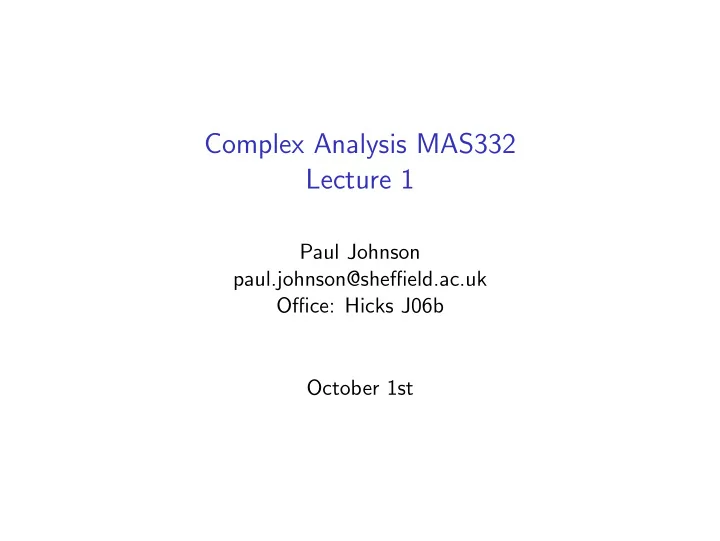

Complex Analysis MAS332 Lecture 1 Paul Johnson paul.johnson@sheffield.ac.uk Office: Hicks J06b October 1st
Complex Analysis: What’s all this, then? Up until now: derivatives and integrals of functions f : R n → R m Derivatives and integrals of f : C → C ◮ Easier than real case! ◮ Analysis not a prerequisite – not focused on doing proofs ◮ Using theorems correctly, building on each other Theorem (Fundamental Theorem of Algebra) Let p ( z ) ∈ C [ x ] be a nonconstant polynomial. Then there is a w ∈ C with p ( w ) = 0 . The Residue Theorem has bonkers applications: � ∞ (1 + x 2 ) 2 dx = π cos( π x ) 2 e − π ( π + 1) −∞
Written Resources Main resource: Dr. Hart’s notes ◮ Fine-tuned toward the exam ◮ Many worked examples Recommended texts: extra material + viewpoints, more rigour ◮ Priestley (pdf through library) ◮ Stewart and Tall (old edition is cheap online) Slides ◮ Posted online before lecture; space to write notes ◮ Roughly follow Dr. Hart’s notes
Assessment and feedback 100% of marks from final exam ◮ Exam questions generally very similar to past years ◮ Four mandatory questions this year instead of five ◮ Forthcoming exam page will have more detail Exercises and feedback ◮ Exercise and hints sheets on MOLE – DO DURING TERM ◮ Will collect a few to mark for feedback ◮ Worked solutions to all exercises will go up shortly after that Interactive “clicker questions” in lecture ◮ Using TurningPoint app/webpage ◮ Everyone gets instant feedback on how things are going
Clicker Session Turning Point app or: ttpoll.edu
Review of complex numbers The complex plane C = { z : z = x + iy ; x , y ∈ R } . ◮ x = Re( z ) is called the real part ◮ y = Im( z ) is called the imaginary part ◮ z = x − iy is called the complex conjugate x 2 + y 2 is called the modulus of z � ◮ | z | = Complex numbers form a field Can add, multiple, subtract by any complex number, and divide by nonzero complex numbers.
A few tricks C ∼ = R 2 An equation z = w of complex numbers can be viewed as a pair of equations between real numbers: z = w ⇐ ⇒ Re( z ) = Re( w ) and Im( z ) = Im( w ) Why care about z ? | z | 2 = z · z This lets us find z − 1 . Example 1 − i What’s 3+4 i ?
Geometry of complex numbers Theorem (Euler) e i θ = cos( θ ) + i sin( θ ) Polar form / “modulus-argument” form If we write z = x + iy in polar coordinates: z = r cos( θ ) + ir sin( θ ) = re i θ Multiplying and dividing easier in polar form! ( re i θ )( se i φ ) = ( rs ) e i ( θ + φ ) re i θ se i φ = ( r / s ) e i ( θ − φ )
Powers and roots Theorem (De Moivre) Let θ ∈ R and n ∈ Z . Then (cos θ + i sin θ ) n = cos n θ + i sin n θ Proof. Apply Euler’s theorem to both sides of ( e i θ ) n = e in θ , or prove directly for n ∈ N using induction and trig formulas. Theorem A complex number z = re i θ has precisely n nth roots: √ re i ( θ +2 k π ) / n n k ∈ { 0 , 1 , . . . , n − 1 }
Recommend
More recommend